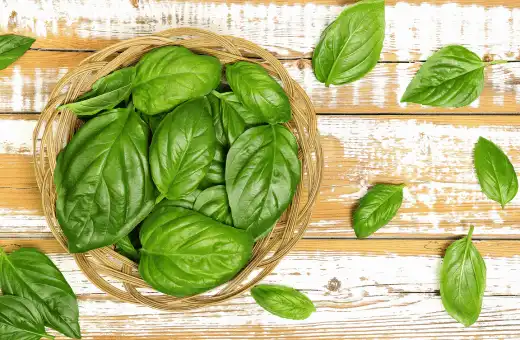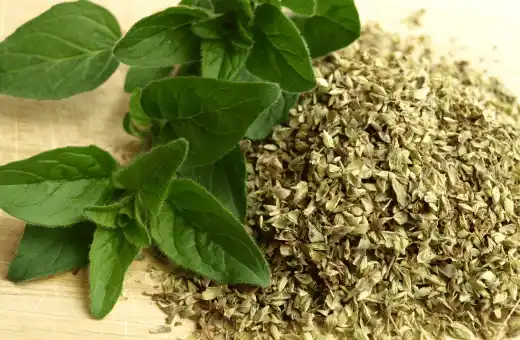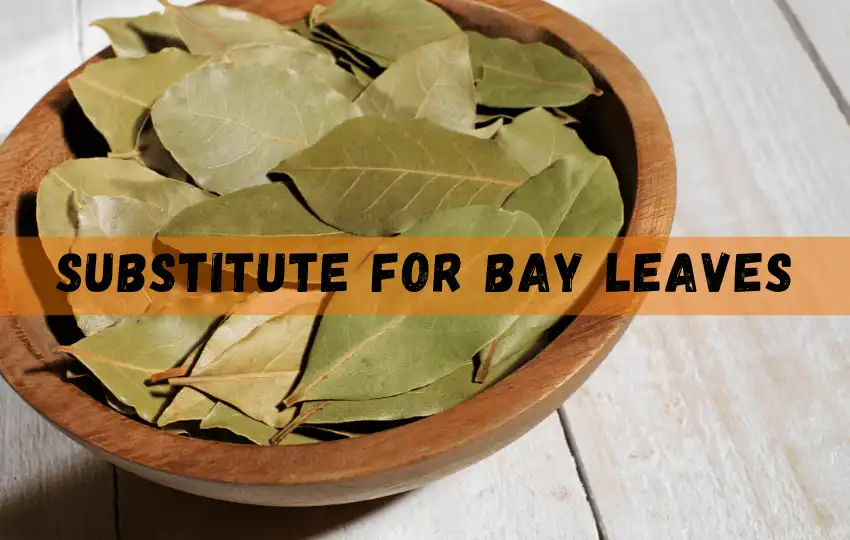Bay leaves are a popular spice used for seasoning savory dishes and the perfect addition to soups, stews, and sauces.
It adds a superb flavor and aroma to any dish, but there may come a time when you’ve run out of bay leaves or you simply can’t find them in your local grocery store.
No worries! Plenty of alternatives are available that can provide a similar taste and fragrance to your dishes.
As an experienced home cook and chef, I have compiled a list of 12 quick substitutes for bay leaves that you can use in your cooking with precise measurements.
In short, " What can I use instead of bay leaves?" Basil Leaves, Thyme, Oregano, Rosemary, Sage, Fennel Seeds, Curry Leaves, Parsley, Celery Leaves, Allspice Berries, Marjoram, and Curry Powder.
What are bay leaves, and what do bay leaves taste like?
Bay leaves are aromatic, flavor-packed leaves that come from the bay laurel tree. They have a slightly bitter and astringent taste when fresh but become milder, woodier and more fragrant when dried.
The most commonly found variety of bay leaves is the dried Mediterranean bay laurel (Laurus nobilis).
Their complex flavor profile includes notes of eucalyptus, oregano, thyme, rosemary, and mint. When added to a dish, they infuse it with a slightly peppery earthiness that complements other herbs and spices perfectly.
The aroma is intense when raw but mellows out during cooking; if using them whole, it’s important to remove them before serving so they don’t overpower the rest of the flavors in the dish.
The flavor of bay leaves is similar to other Mediterranean herbs like oregano or thyme but with an earthy complexity that works great in savory dishes.
Uses of bay leaves for cooking
Bay leaves are a flavorful and aromatic addition to many dishes. They can be used in soups, stews, stocks, marinades, and stuffings.
Bay leaves add an earthy depth of flavor to savory dishes such as sauces, curries, and rice pilafs. They can also be used for sweet treats like puddings and syrups.
Bay leaves have been utilized since ancient times for their culinary and medicinal properties.
In antiquity, bay laurel wreaths were given to poets and scholars as symbols of their intelligence and wit; these wreaths were later adopted by early Olympic athletes as an expression of victory.
To get the most flavor from bay leaves, it is important not to grind them up or crush them before adding them to the dish; this will only release some volatile compounds while leaving behind much of their flavor potential.
To really bring out their full flavor, they should be simmered with other ingredients for at least 30 minutes or so prior to serving; this will allow all of their essential oils to dissolve into the other flavors in the dish.
Where to buy bay leaves?
If you searching for where to buy bay leaves, there are a few different places you can go. Many specialty food stores carry it, as do some international grocery stores.
You can also order online from many retailers that provide a variety of diverse flavors and types of bay leaves.
Best substitutes for bay leaves with measurement
1. Basil Leaves

Basil leaves are one of the closest substitutes to bay leaves as it also belongs to the mint family. It offers a sweet and herbaceous flavor to any dish.
Ratio or measurement: You can use 1 teaspoon of dried basil in place of 2 bay leaves.
2. Thyme
Thyme has a similar earthy and spicy taste and scent to bay leaves. It’s perfect for seasoning meat dishes, stews, and soups.
Ratio or measurement: You can replace 2 bay leaves with 1 tablespoon of dried thyme.
3. Oregano

One of my favorite Oregano is another herb that belongs to the mint family.
Ratio or measurement: Substitute 2 bay leaves with 1 tablespoon of dried oregano for a slightly spicier flavor.
4. Rosemary
Rosemary is a woody herb that works well as a substitute when you don’t have bay leaves.
Ratio or measurement: Use 1 tablespoon of dried rosemary in place of 2 bay leaves for its pine-like flavor.
5. Sage

Sage leaves have a savory and earthy flavor that can be used in tomato sauce, stews, and soups.
Ratio or measurement: You can replace 2 bay leaves with 1 tablespoon of dried sage.
6. Fennel Seeds
Fennel seeds are another good substitute for bay leaves.
Ratio or measurement: You can use 1 teaspoon of fennel seeds instead of 2 bay leaves for their licorice-like flavor.
7. Curry Leaves

Curry leaves are a famous ingredient in Indian cuisine with a slightly sweet and tangy flavor.
Ratio or measurement: Use 2-3 curry leaves in place of 1 bay leaf for a different depth of flavor.
8. Parsley
Parsley is a famous herb that can be used as a substitute for bay leaves.
Ratio or measurement: Use 2 tablespoons of fresh parsley in place of 2 bay leaves or 1 tablespoon of dried parsley.
9. Celery Leaves

Celery leaves have a savory taste with a little bitterness.
Ratio or measurement: Use 1 teaspoon of celery leaves instead of 1 bay leaf for seasoning soups and stews.
10. Allspice Berries
Allspice has a sweet and spicy flavor with hints of cinnamon, nutmeg, and clove.
Ratio or measurement: Crush 1 allspice berry and use it instead of 2 bay leaves to season your dishes.
11. Marjoram
Marjoram is a herb from the same family as oregano. It has a milder flavor than sage and thyme, but it is an excellent alternative to bay leaves.
Ratio or measurement: Use two teaspoons of dried marjoram for each bay leaf.
12. Curry Powder
Curry powder has a complex flavor profile that includes bay leaf as one of its ingredients.
Ratio or measurement: If you don't have any bay leaves, you can use one teaspoon of curry powder for every bay leaf called for in the recipe.
Learn more: Best Kaffir Lime Leaves Substitutes
Asian bay leaf substitute
One of the most popular substitutes for Asian bay leaves is aromatic Indian bay leaves, which have a similar flavor and aroma.
The leaves are often used in traditional Indian dishes such as Dal Makhani, a rich lentil stew. They can also be used in curries, marinades, and slow-cooked stews.
Another substitute for Asian bay leaves is cassia bark, also known as Chinese cinnamon. This spice has a bold flavor with hints of allspice and clove that can add depth to many dishes.
It’s best used as part of a blend rather than on its own since its flavor can be overpowering if it’s used in too large quantities.
Star anise is another great substitute for Asian bay leaves. This eight-pointed star-shaped pod has an intense licorice-like flavor that complements many savory dishes.
Whole star anise pods can be added to soups and stews, while ground star anise powder can be added to marinades and rubs.
Nutmeg is yet another great substitute for Asian bay leaves, with mild nutty and sweet flavors that pair nicely with both sweet dishes and savory.
Whole nutmeg grated over salads or added to sauces and custards adds complexity to dishes without overpowering the other flavors.
Cloves are the last substitution for Asian bay leaves on this list but certainly not least! Clove buds have a warm spicy aroma that enhances many savory dishes like soups, stews, marinades, curries and more.
They are best used sparingly since their strong flavor can easily overpower other ingredients in the dish if used in large amounts.
Substitute for bay leaf in a stew
A bay leaf can be substituted in a stew with other herbs and spices. Fresh thyme, rosemary, and oregano are all flavorful alternatives that pair well with a variety of different meats and vegetables.
Additionally, crushed red pepper flakes and garlic powder can also add a deeper level of flavor to the dish.
While each herb or spice will impart its own unique taste, they work together to create a complex layer of flavors that makes stew so enjoyable.
When making a substitution for bay leaf, it is important to remember that the amount used should be reduced by half since these herbs are much more potent than their dried counterpart.
If unsure how much to use, start with a smaller amount and adjust as needed for desired results.
Substitute for bay leaf in adobo
Adobo is a type of Filipino dish made with vinegar-based marinade. Bay leaves are often used to add a subtle, herbal flavor to the dish but can be difficult to find in some regions.
Fortunately, there are many more alternatives that can be used as an alternative for bay leaves in adobo.
One alternative would be to use a blend of dried herbs like rosemary, oregano and thyme or epazote, an herb native to Mexico and Central America.
This combination will provide similar flavors as the original bay leaf while adding unique notes of its own. Additionally, ground cloves and allspice can be used as they have a similar spicy flavor that works well in adobo dishes.
Another choice would be to use fresh herbs if available. Fresh parsley or cilantro can also provide flavorful notes that mimic the taste of bay leaves while adding vibrant color to your dish.
Similarly, garlic powder and onion powder can bring out the savory elements of the marinade without being too overpowering.
In conclusion, there are several substitutes for bay leaves in adobo dishes that will help you create flavorful meals with unique touches depending on your preference and availability of ingredients.
With these alternatives, you’ll still get delicious adobo with an added depth of flavor without having to go out in search of bay leaves.
Substitute for bay leaf in chicken soup
For a flavorful alternative to bay leaves in chicken soup, consider adding fresh or dried thyme. Thyme is similar to bay leaves in flavor, aroma and culinary function, but it can add an extra layer of spicy complexity to soups.
Thyme is a perennial herb plant that belongs to the mint family and grows as a shrub-like plant with small, pungent leaves.
It has been utilized in cooking for thousands of years because of its strong flavor and anti-bacterial properties. It’s also known for promoting deep relaxation and aiding digestion, which is why it’s often used in herbal teas.
To use thyme in substitution for bay leaf in chicken soup, start by grinding about 1 teaspoon of the herb into a powder using a mortar and pestle or food processor.
Then add the powder directly to the soup during the cooking process. Be sure not to overcook the soup, or else the thyme will become bitter and unpalatable.
Conclusion on substitute for bay leaves
Not having bay leaves should never hold you back from making your favorite dishes. These 12 substitutes are great alternatives that will deliver similar flavor and aroma to your dishes.
Whether you choose to use rosemary or thyme, curry leaves, or fennel seeds, your dishes will still be delicious.
Just remember to take note of the precise measurements when substituting. With these quick substitutes handy, you can never go wrong in the kitchen! Happy cooking!
FAQs on substitute for bay leaves
Q1. What is closest to bay leaf?
If you don’t have bay leaves on hand and need a substitute, there are several herbs and spices that can provide a similar flavor profile. Here are some of the closest substitutes to bay leaf:
1. Thyme: Thyme has a similar earthy, herbal flavor as bay leaf and can be used in many of the same recipes. It is used as fresh or dried and is often used in stews, soups, and meat dishes.
2. Oregano: Oregano has a slightly more pungent and spicy flavor than a bay leaf but can be used in similar recipes, especially those with a Mediterranean or Mexican influence. It is often used in tomato-based sauces, as well as in meat and vegetable dishes.
3. Rosemary: Rosemary has a strong, pine-like flavor that can provide a similar earthy flavor as bay leaf. It pairs well with meat dishes, roasted vegetables, and tomato-based sauces.
4. Sage: Sage has a savory and slightly bitter flavor that can be used as a substitute for bay leaf in soups, stews, and meat dishes. It is used as fresh or dried and is often used in Italian and Mediterranean cuisine.
5. Basil: Basil has a sweet and slightly peppery flavor that can provide a subtle alternative to bay leaf in many recipes. It is often used in tomato-based sauces, as well as in salads, pesto, and pasta dishes.
Overall, thyme, oregano, rosemary, sage, and basil are some of the closest substitutes to bay leaf in terms of flavor profile. However, it’s necessary to remember that these herbs and spices will not provide an exact replication of the unique flavor of bay leaf, so it’s best to use them as a close approximation when needed.
Q2. Can I substitute basil for bay leaves?
Yes, you can substitute basil for bay leaves in many recipes. While both herbs are strongly aromatic and often used as seasoning agents, they have a few key differences. Bay leaves have an earthy, sweet flavor, while basil is more peppery and it has a hint of mint and licorice.
Moreover, bay leaves are usually used whole in dishes to be removed before serving, while basil is normally added near the end of cooking or used as a garnish.
Q3. What flavor does a bay leaf add to a recipe?
A bay leaf adds an intensely herbal, earthy flavor to any recipe. The aroma of the bay leaf is slightly minty, with notes of eucalyptus and floral overtones. It’s often used to add depth and complexity to various dishes, from stews and soups to marinades and sauces.
When used in moderation, it can also add a mild sweetness that helps balance the saltiness of many recipes. Bay leaves should be added early in the cooking process to allow their flavors to steep into the dish for maximum impact. They should not be eaten directly as they can be quite bitter.
Q4. What herbs are similar to bay leaves?
Bay leaves arrive from the Laurus nobilis tree, native to the Mediterranean region. They have an aromatic, slightly floral flavor and are often used as a seasoning for stews, soups, and braises. Other herbs that have similar flavor profiles to bay leaves include thyme, rosemary, oregano and marjoram.
All of these herbs are part of the mint family (Lamiaceae) and produce fragrant oils which give them their distinct flavor. Thyme has a more citrus-forward flavor, while oregano is slightly spicier with notes of warm pepper and nutmeg.
Rosemary has a sharp, piney taste, while marjoram is sweeter and milder on the palate. These herbs can be used in similar ways as bay leaves – either whole or ground into powders – as part of dry rubs or herbal blends for soups & stews.
Q5. Can you substitute sage for bay leaves?
No, bay leaves should not be substituted with sage. Although both are aromatic herbs commonly used in cooking, their flavor profiles are quite different. Bay leaves have a woodsy and earthy flavor profile that is not easily replicated with other herbs.
Sage has a strong, pungent and savory taste, which can overpower dishes if too much is added. For best results, it’s recommended to use the herb specified in the recipe.

